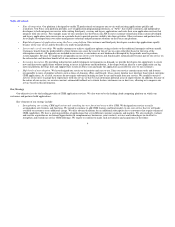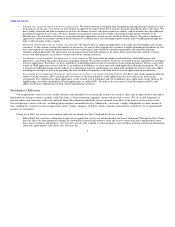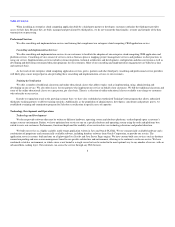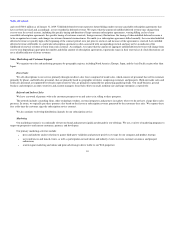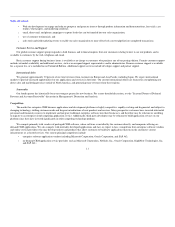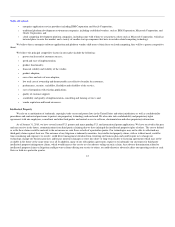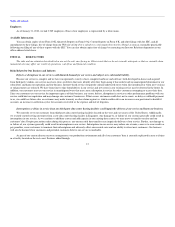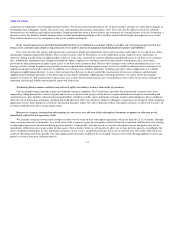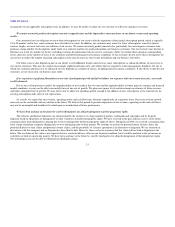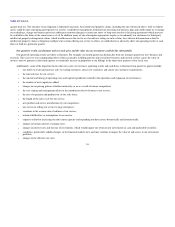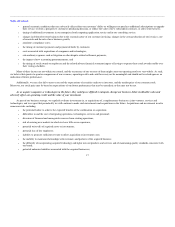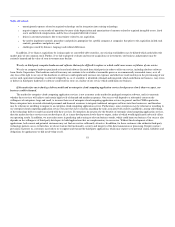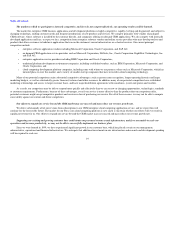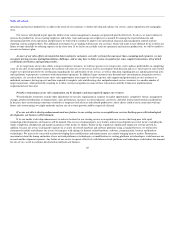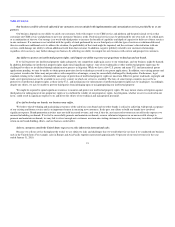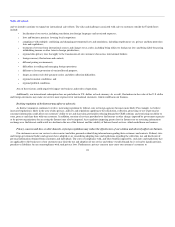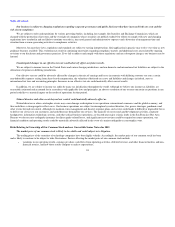Salesforce.com 2009 Annual Report Download - page 17
Download and view the complete annual report
Please find page 17 of the 2009 Salesforce.com annual report below. You can navigate through the pages in the report by either clicking on the pages listed below, or by using the keyword search tool below to find specific information within the annual report.
Table of Contents
acquisition are temporarily served through alternate facilities. We do not control the operation of any of these facilities, and they are vulnerable to damage or
interruption from earthquakes, floods, fires, power loss, telecommunications failures and similar events. They may also be subject to break-ins, sabotage,
intentional acts of vandalism and similar misconduct. Despite precautions taken at these facilities, the occurrence of a natural disaster or an act of terrorism, a
decision to close the facilities without adequate notice or other unanticipated problems at these facilities could result in lengthy interruptions in our service.
Even with the disaster recovery arrangements, our service could be interrupted.
If our security measures are breached and unauthorized access is obtained to a customer's data or our data, our service may be perceived as not
being secure, customers may curtail or stop using our service and we may incur significant legal and financial exposure and liabilities.
Our service involves the storage and transmission of customers' proprietary information, and security breaches could expose us to a risk of loss of this
information, litigation and possible liability. These security measures may be breached as a result of third-party action, employee error, malfeasance or
otherwise, during transfer of data to additional data centers or at any time, and result in someone obtaining unauthorized access to our data or our customers'
data. Additionally, third parties may attempt to fraudulently induce employees or customers into disclosing sensitive information such as user names,
passwords or other information in order to gain access to our data or our customers' data. Because the techniques used to obtain unauthorized access, or to
sabotage systems, change frequently and generally are not recognized until launched against a target, we may be unable to anticipate these techniques or to
implement adequate preventative measures. In addition, our customers may authorize third party technology providers, whose applications are available
through our AppExchange directory, to access their customer data. Because we do not control the transmissions between our customers and third-party
AppExchange technology providers, or the processing of such data by third-party AppExchange technology providers, we cannot ensure the complete
integrity or security of such transmissions or processing. Any security breach could result in a loss of confidence in the security of our service, damage our
reputation, lead to legal liability and negatively impact our future sales.
Weakened global economic conditions may adversely affect our industry, business and results of operations.
Our overall performance depends in part on worldwide economic conditions. The United States and other key international economies have been
impacted by falling demand for a variety of goods and services, restricted credit, going concern threats to major multinational companies and medium and
small businesses, poor liquidity, reduced corporate profitability, volatility in credit, equity and foreign exchange markets and bankruptcies. These conditions
affect the rate of information technology spending and could adversely affect our customers' ability or willingness to purchase our enterprise cloud computing
application service, delay prospective customers' purchasing decisions, reduce the value or duration of their subscription contracts, or affect renewal rates, all
of which could adversely affect our operating results.
Because we recognize revenue from subscriptions for our service over the term of the subscription, downturns or upturns in sales may not be
immediately reflected in our operating results.
We generally recognize revenue from customers ratably over the terms of their subscription agreements, which are typically 12 to 24 months, although
terms can range from one to 60 months. As a result, most of the revenue we report in each quarter is derived from the recognition of deferred revenue relating
to subscription agreements entered into during previous quarters. Consequently, a decline in new or renewed subscriptions in any one quarter may not be
immediately reflected in our revenue results for that quarter. Such a decline, however, will negatively affect our revenue in future quarters. Accordingly, the
effect of significant downturns in sales and market acceptance of our service, and potential changes in our rate of renewals may not be fully reflected in our
results of operations until future periods. Our subscription model also makes it difficult for us to rapidly increase our revenue through additional sales in any
period, as revenue from new customers must be
14


